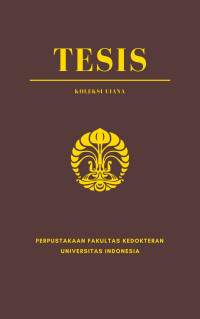Tesis
Kemampuan Infeksi Virus Kimera Simian Human Immunodeficiency Virus (SHIVst) pada Kultur Sel HT-29 = Infectivity of Chimeric Simian Human Immunodeficiency Virus (SHIVst) in HT29 cells.
Simian Human Immunodeficiency Virus (SHIV) merupakan virus kimera yang berasal dari rekombinasi antara HIV yang dapat menginfeksi manusia dan SIV yang dapat menginfeksi primata non manuisa. Pada penelitian ini, dilakukan substitusi sekuens gen virus kimera pada sekuens gen gag, yaitu Cyclophilin A binding domain, gen vif, dan gen nef. Hasil rekombinasi pada virus kimera SHIV diinfeksikan pada sel HT-29 yang memiliki alternatif molekul yang dapat mengenali reseptor gp120, yaitu galaktosilseremida. Uji infektivitas virus kimera SHIVst ini bertujuan untuk melihat kemampuan infeksi virus kimera melalui analysis keberadaan materi genetik yaitu RNA virus dan protein kapsid, yaitu p24. Hasil yang diperoleh virus kimera dapat dihasilkan melalui transfeksi pada sel CHO terdapat pita RNA virus yang terbentuk pasca amplifikasi. Selain itu, analisis kebaradaan protein p24 juga terkonfirmasi melalui western blot dan ELISA antigen p24 dari supernatant pasca transfeksi. Namun, pada hasil infeksi virus kimera yang dilakukan pada sel HT-29, keberadaan RNA virus melalui tahapan amplifikasi baik PCR konvensional maupun RT PCR tidak menunjukkan terbentuknya pita spesifik RNA virus. Oleh karena itu, virus kimera SHIVst tidak bisa menginfeksi sel HT29.
Kata kunci: HIV, SIV, SHIVst, Infektivitas, Kultur Sel HT-29
Simian Human Immunodeficiency Virus (SHIV) is a chimeric virus originating from recombination between HIV which can infect humans and SIV which can infect non-human primates. In this study, chimera virus gene sequences were substituted for gag gene sequences, namely Cyclophilin A binding domain, vifgene, and nef gene. SHIVst was infected with HT-29 cells which have an alternative molecule that can recognize the gp120 receptor, namely galactosylceremide. The infectivity test of the SHIVst chimera virus was aimed at assessing the infectivity of the chimera virus through analysis of the presence of viral RNA and capsid protein, p24. The results obtained by the chimera virus can be produced by transfection in CHO cells, there are viral RNA bands formed after amplification. In addition, analysis of the presence of p24 protein was also confirmed by western blot and p24 antigen ELISA of the post-transfection supernatant. However, in the results of SHIVst infection HT-29 cells, the presence of viral RNA through the amplification stages of both conventional PCR and RT PCR did not show the formation of viral RNA-specific bands. Therefore, the SHIVst chimeric virus could not infect HT29 cells.
Key words: HIV, SIV, SHIV, Infectivity, HT-29 Cell Culture.
- Judul Seri
-
-
- Tahun Terbit
-
2022
- Pengarang
-
Dora Syakina Desriana - Nama Orang
Silvia Tri Widyaningtyas - Nama Orang
Budiman Bela - Nama Orang - No. Panggil
-
T22614fk
- Penerbit
- Jakarta : Program Magister Ilmu Biomedik., 2022
- Deskripsi Fisik
-
xix, 118 hlm., ; 21 x 30 cm
- Bahasa
-
Indonesia
- ISBN/ISSN
-
SBP Online
- Klasifikasi
-
NONE
- Edisi
-
-
- Subjek
- Info Detail Spesifik
-
Tanpa Hardcopy
| T22614fk | T22614fk | Perpustakaan FKUI | Tersedia |


Masuk ke area anggota untuk memberikan review tentang koleksi